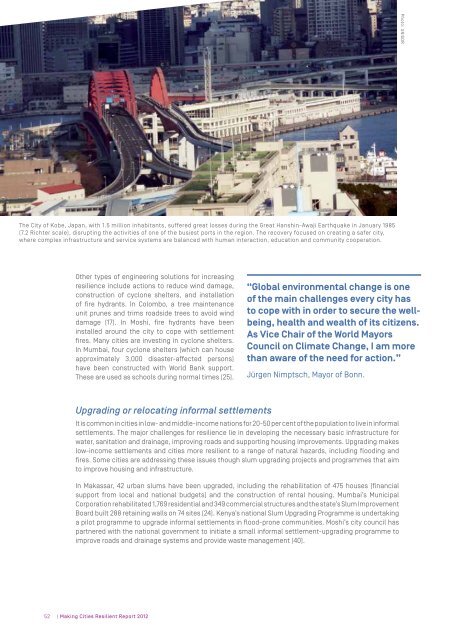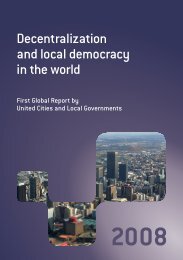Making Cities Resilient Report 2012
Making Cities Resilient Report 2012
Making Cities Resilient Report 2012
You also want an ePaper? Increase the reach of your titles
YUMPU automatically turns print PDFs into web optimized ePapers that Google loves.
Photo: UNISDR<br />
The City of Kobe, Japan, with 1.5 million inhabitants, suffered great losses during the Great Hanshin-Awaji Earthquake in January 1985<br />
(7.2 Richter scale), disrupting the activities of one of the busiest ports in the region. The recovery focused on creating a safer city,<br />
where complex infrastructure and service systems are balanced with human interaction, education and community cooperation.<br />
Other types of engineering solutions for increasing<br />
resilience include actions to reduce wind damage,<br />
construction of cyclone shelters, and installation<br />
of fire hydrants. In Colombo, a tree maintenance<br />
unit prunes and trims roadside trees to avoid wind<br />
damage (17). In Moshi, fire hydrants have been<br />
installed around the city to cope with settlement<br />
fires. Many cities are investing in cyclone shelters.<br />
In Mumbai, four cyclone shelters (which can house<br />
approximately 3,000 disaster-affected persons)<br />
have been constructed with World Bank support.<br />
These are used as schools during normal times (25).<br />
“Global environmental change is one<br />
of the main challenges every city has<br />
to cope with in order to secure the wellbeing,<br />
health and wealth of its citizens.<br />
As Vice Chair of the World Mayors<br />
Council on Climate Change, I am more<br />
than aware of the need for action.”<br />
Jürgen Nimptsch, Mayor of Bonn.<br />
Upgrading or relocating informal settlements<br />
It is common in cities in low- and middle-income nations for 20-50 per cent of the population to live in informal<br />
settlements. The major challenges for resilience lie in developing the necessary basic infrastructure for<br />
water, sanitation and drainage, improving roads and supporting housing improvements. Upgrading makes<br />
low-income settlements and cities more resilient to a range of natural hazards, including flooding and<br />
fires. Some cities are addressing these issues though slum upgrading projects and programmes that aim<br />
to improve housing and infrastructure.<br />
In Makassar, 42 urban slums have been upgraded, including the rehabilitation of 475 houses (financial<br />
support from local and national budgets) and the construction of rental housing. Mumbai’s Municipal<br />
Corporation rehabilitated 1,769 residential and 349 commercial structures and the state’s Slum Improvement<br />
Board built 288 retaining walls on 74 sites (24). Kenya’s national Slum Upgrading Programme is undertaking<br />
a pilot programme to upgrade informal settlements in flood-prone communities. Moshi’s city council has<br />
partnered with the national government to initiate a small informal settlement-upgrading programme to<br />
improve roads and drainage systems and provide waste management (40).<br />
52 | <strong>Making</strong> <strong>Cities</strong> <strong>Resilient</strong> <strong>Report</strong> <strong>2012</strong>

















